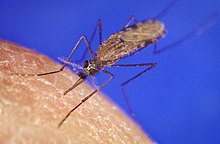| Culicomorpha | |
|---|---|

| |
| Scientific classification | |
| Domain: | Eukaryota |
| Kingdom: | Animalia |
| Phylum: | Arthropoda |
| Class: | Insecta |
| Order: | Diptera |
| Suborder: | Nematocera |
| Infraorder: | Culicomorpha Hennig, 1948 |
| Superfamilies | |
|
Culicoidea | |
The Culicomorpha are an infraorder of Nematocera, including mosquitoes, black flies, and several extant and extinct families of insects. They originated 176 million years ago, in the Triassic period. There are phylogenetic patterns that are used to interpret bionomic features such as differences in the nature of blood-feeding by adult females, daytime or nighttime feeding by adult females, and occurrence of immature stages in aquatic habitats.
Most adult, females lay their eggs on bodies of water. Some are restricted to very clean waters, but others can tolerate highly polluted environments.
Many adults transmit parasites or diseases that can be debilitating or fatal to humans, such as malaria and West Nile virus. Biting midges can transmit an extensive range of pathogens of veterinary importance, including Akabane virus, bovine ephemeral fever virus, Schmallenberg virus, African horse sickness virus, epizootic haemorrhagic disease virus, and bluetongue virus.
Classification
The Culicomorpha comprises extant eight families divided into two superfamilies. It was described based on phylogenetic analyses of morphological features.
- Superfamily Culicoidea
- Dixidae -meniscus midges
- Corethrellidae -frog-biting midges
- Chaoboridae -phantom midges
- Culicidae -mosquitoes
- Superfamily Chironomoidea
- Thaumaleidae -solitary midges
- Simuliidae -black flies and buffalo gnats
- Ceratopogonidae -biting midges
- Chironomidae -nonbiting midges
The monophyly of Culicomorpha and Culicoidea have been confirmed in subsequent morphological and molecular studies, but several studies have found Chironomoidea to be paraphyletic. A morphological study in 2012, using characters from all life stages (egg, larva, pupae and adult), found that Chironomidae branched first and a sister relationship between Culicoidea and a clade of Simuliidae, Ceratopogonidae and Thamaleidae. A new superfamily, Simulioidea, was proposed for the latter clade and restricted Chironomoidea to Chironomidae. A phylogenomic analysis in 2018 also found a paraphyletic Chironomoidea and a close relationship between Simuliidae and Thamaleidae, but in this study Ceratopoginidae grouped with Chironomidae. The phylogenetic trees below illustrate the different arrangements.
|
|
|
Extinct families
- Asiochaoboridae (Upper Jurassic)
- Architendipedidae (Upper Triassic)
- Protendipedidae (Middle Jurassic)
- Mesophantasmatidae (Middle Jurassic)
References
- ^ Borkent, Art (2012). "The pupae of Culicomorpha : morphology and a new phylogenetic tree" (PDF). Zootaxa. 3396 (1). doi:10.11646/zootaxa.3396.1. ISBN 978-1-86977-957-3. OCLC 807999306.
- Ecology and General Biology. James H. Thorp, D. Christopher Rogers (4th ed.). London: Academic Press. 2015. ISBN 978-0-12-385027-0. OCLC 899273856.
{{cite book}}: CS1 maint: others (link) - Carpenter, Simon; Groschup, Martin H.; Garros, Claire; Felippe-Bauer, Maria Luiza; Purse, Bethan V. (October 2013). "Culicoides biting midges, arboviruses and public health in Europe". Antiviral Research. 100 (1): 102–113. doi:10.1016/j.antiviral.2013.07.020. ISSN 1872-9096. PMID 23933421.
- Carpenter, S.; Veronesi, E.; Mullens, B.; Venter, G. (April 2015). "Vector competence of Culicoides for arboviruses: three major periods of research, their influence on current studies and future directions". Revue Scientifique et Technique (International Office of Epizootics). 34 (1): 97–112. doi:10.20506/rst.34.1.2347. ISSN 0253-1933. PMID 26470451.
- ^ Wood, D. M.; Borkent, A. (1989). "Phylogeny and Classilication of the Nematocera". In McAlpine, J.F.; Woods, D.M. (eds.). Manual of Nearctic Diptera, vol. 3 (PDF). Ottawa: Agriculture Canada Research Branch.
- ^ Yeates, David K.; Weigmann, Brian M; Courtney, Greg W.; Meier, Rudolf; Lambkins, Christine; Pape, Thomas (2007). "Phylogeny and systematics of Diptera: Two decades of progress and prospects". Zootaxa. 1668: 565–590. doi:10.11646/zootaxa.1668.1.27.
- ^ Bertone, Matthew A.; Courtney, Gregory W.; Wiegmann, Brian M. (2008). "Phylogenetics and temporal diversification of the earliest true flies (Insecta: Diptera) based on multiple nuclear genes" (PDF). Systematic Entomology. 33 (4): 668–687. doi:10.1111/j.1365-3113.2008.00437.x. S2CID 54781592.
- ^ Narayanan Kutty, Sujatha; Wong, Wing Hing; Meusemann, Karen; Meier, Rudolf; Cranston, Peter S. (2018). "A phylogenomic analysis of Culicomorpha (Diptera) resolves the relationships among the eight constituent families". Systematic Entomology. 43 (3): 434–446. doi:10.1111/syen.12285. S2CID 90255287.
| Taxon identifiers | |
|---|---|
| Culicomorpha |
|
This article related to members of the fly infraorder Culicomorpha is a stub. You can help Misplaced Pages by expanding it. |